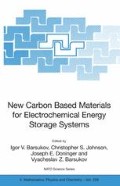Abstract
Three types of novel carbon materials, such as KOH-activated microporous carbons, highly ordered carbons obtained by a template technique, and a special carbon/carbon composite based on carbon nanotubes with carbonized polyacrylonitrile have been used as electrodes for supercapacitors in aqueous and organic electrolytes. The various carbon materials used allow their capacitance properties to be correlated with the total surface area, micro and meso pore volume, elemental composition. Especially, the role of mesopores in charge propagation was strongly underlined. The capacitance values widely range from 100 to 300 F/g depending on the carbon microtexture but also on the heteroatom (nitrogen) content responsible for pseudocapacitance effects. Comparison of these three classes of carbon materials gives a basic knowledge for optimization of supercapacitor electrode materials depending on electrolytic solutions used.
Access this chapter
Tax calculation will be finalised at checkout
Purchases are for personal use only
Preview
Unable to display preview. Download preview PDF.
REFERENCES
Conway B.E. Electrochemical Supercapacitors. Kluwer Academic/Plenum Publishers, New York, 1999.
Frackowiak E., Béguin F. Carbon materials for the electrochemical storage of energy in capacitors. Carbon 2001; 39: 937–50.
Mayer S.T., Pekala R.W., Kaschmitter J.L. The aeorocapacitor: an electrochemical double-layer energy-storage device. J Electrochem Soc 1993; 140:446–51.
Laforgue A., Simon P., Sarrazin Ch., Fauvarque J-F. Polythiophene-based supercapacitors. J Power Sourc 1999; 80:142–8.
Frackowiak E., Jurewicz K., Delpeux S., Béguin F. Nanotubular materials for supercapacitors. J Power Sourc 2001; 97–98:822–5.
Jurewicz K., Delpeux S., Bertagna V., Béguin F., Frackowiak E. Supercapacitors from nanotubes/polypyrrole composites. Chem Phys Lett 2001; 347: 36–40.
Arbizzani C., Mastragostino M., Soavi F. New trends in electrochemical supercapacitors. J Power Sourc 2001; 100:164–170.
Miller J.M., Dunn B., Tran T.D., Pekala R.W. Morphology and electrochemistry of ruthenium/carbon/aerogel nanostructures. Langmuir 1999; 15:799–806.
Toupin M., Brousse T., Bélanger D. Influence of microtexture on the charge storage properties of chemically synthesized manganese dioxide, Chem Mater 2002; 14:3946–52.
Wu N.L. Nanocrystalline oxide supercapacitors. Mater Chem Phys 2002; 75:6–11.
Frackowiak E., Méténier K., Bertagna V., Béguin F. Supercapacitor electrodes from multiwalled carbon nanotubes. Appl Phys Lett 2000; 77:2421–3.
Jurewicz K, Babel K., Ziolkowski A., Wachowska H. Ammoxidation of active carbons for improvement of supercapacitor characteristics. Electrochim Acta 2003; 48:1491–8.
Kierzek K., Frackowiak E., Lota G., Gryglewicz G., Machnikowski J. Electrochemical capacitors based on highly porous carbons prepared by KOH activation Electrochim Acta 2004; 49:515–23.
Frackowiak E., Delpeux S., Jurewicz K., Szostak K., Cazorla-Amoros D., Béguin F. Enhanced capacitance of carbon nanotubes through chemical activation. Chem Phys Lett 2002; 361: 35–41.
Galarneau A., Cambon H., Di Renzo F., Fajula F. True microporosity and surface area of mesoporous SBA-15 silicas as a function of synthesis temperature. Langmuir 2001; 17:8328.
Ryoo R., Joo S.H., Kruk M., Jaroniec M. Ordered mesoporous carbons Adv Mater 2001; 13:677–81.
Fuertes A.B. Template synthesis of mesoporous carbons with a controlled particle size, J. Mater. Chem. 2003; 13:3085–8.
Jurewicz K., Vix C., Frackowiak E., Saadallach S., Reda M., Parmentier J., Patarin J., Béguin F. Capacitance properties of ordered porous carbon materials prepared by a templating procedure. J Phys Chem Solids (2004) in press.
Delpeux S., Szostak K., Frackowiak E., Bonnamy S., Beguin F. High yield carbon nanotubes from the catalytic decomposition of acetylene on in-situ formed Co nanoparticles. J Nanosci Nanotech 2002; 2: 481–4.
Szostak K., Frackowiak E., Delpeux S., Béguin F. CD-ROM G-1 Carbon'03 Oviedo Spain (2003).
Author information
Authors and Affiliations
Editor information
Editors and Affiliations
Rights and permissions
Copyright information
© 2006 Springer
About this paper
Cite this paper
Frackowiak, E., Machnikowski, J., Béguin, F. (2006). NOVEL CARBONACEOUS MATERIALS FOR APPLICATION IN THE ELECTROCHEMICAL SUPERCAPACITORS. In: Barsukov, I.V., Johnson, C.S., Doninger, J.E., Barsukov, V.Z. (eds) New Carbon Based Materials for Electrochemical Energy Storage Systems: Batteries, Supercapacitors and Fuel Cells. NATO Science Series II: Mathematics, Physics and Chemistry, vol 229. Springer, Dordrecht. https://doi.org/10.1007/1-4020-4812-2_1
Download citation
DOI: https://doi.org/10.1007/1-4020-4812-2_1
Publisher Name: Springer, Dordrecht
Print ISBN: 978-1-4020-4810-4
Online ISBN: 978-1-4020-4812-8
eBook Packages: Chemistry and Materials ScienceChemistry and Material Science (R0)

